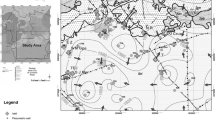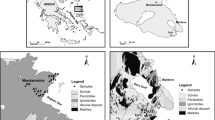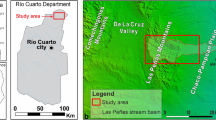Abstract
Arsenic occurrence in groundwater near the Cimino-Vico volcanoes (central Italy) was analysed considering the hydrostratigraphy and structural setting and the shallow and deep flows interacting within the Quaternary volcanics. Groundwater is the local source of drinking water. As documented in the past, arsenic in the groundwater has become a problem, and the European maximum allowable contaminant level was recently lowered to 10 μg/L. Chemical analyses of groundwater were conducted, sampled over an area of about 900 km2, from 65 wells and springs representative of the volcanic aquifer and thermal waters. Considering the type of aquifer, the nature of the aquifer formation and its substratum, the hydrochemical data highlight that the arsenic content of the groundwater is mainly connected with the hydrothermal processes in the volcanic area. Thermal waters (54–60°C) fed from deep-rising fluids show higher arsenic concentrations (176–371 μg/L). Cold waters sampled from the volcanic aquifer are characterized by a wide variability in their arsenic concentration (1.6–195 μg/L), and about 62% exceed the limit of 10 μg/L. Where the shallow volcanic aquifer is open to deep-rising thermal fluids, relatively high arsenic concentrations (20–100 μg/L) are found. This occurs close to areas of the more recent volcano-tectonic structures.
Résumé
La présence d’arsenic dans les eaux souterraines près des volcans de Cimino-Vico (Italie Centrale) a été analysée en considérant les paramètres hydrostatiques et structuraux et les flux superficiels et plus profonds interagissant avec les volcans Quaternaires. L’eau souterraine est utilisée localement comme eau potable. Comme observé précédemment, l’arsenic dans les eaux souterraines est devenu un problème et, au niveau européen, la concentration maximale tolérée a récemment été abaissée à 10 μg/L. Sur une surface de 900 km2, une campagne d’échantillonnage a été organisée et les analyses chimiques effectuées sur 65 puits et sources représentatifs de l’aquifère volcanique et eaux thermales. Considérant ce type d’aquifère, la nature des formations aquifères et substratum, les données hydrochimiques montrent que les teneurs en arsenic dans les eaux souterraines sont principalement liées aux processus thermaux dans le secteur des volcans. Les eaux thermales (54–60°C) provenant des fluides d’origine profonde ont des concentrations élevées en arsenic (176–371 μg/L). Les eaux froides de l’aquifère volcanique sont caractérisées par des concentrations en arsenic très variables (1.6–195 μg/L) dont environ 62% dépassent la limite de 10 μg/L. Lorsque l’aquifère volcanique peu profond est influencé par les eaux thermales profondes, à proximité des structures volcano-tectoniques les plus récentes, des concentrations fortes en arsenic ont été mesurées (20–100 μg/L).
Resumen
La existencia de arsénico en las aguas subterráneas en las proximidades de los volcanes de Cimino - Vico (Italia central) fue analizada considerando los esquemas hidroestratigráfico y estructural y la interacción de los flujos profundos y someros dentro de los volcanes Cuaternarios. El agua subterránea es la fuente local de agua potable. Tal como fue documentado en el pasado, el arsénico en las aguas subterráneas se ha convertido en un problema, y nivel máximo del contaminante permitido en Europa fue recientemente reducido a 10 μg/L. Se realizaron análisis químicos de las aguas subterráneas, muestreándose 65 pozos y manantiales en una superficie de unos 900 km2, los cuales son representativos del acuífero volcánico y de las aguas termales. Considerando el tipo de acuífero, la naturaleza de la formación acuífera y su sustrato, en los datos hidroquímicos se destaca que el contenido de arsénico en las aguas subterráneas está fundamentalmente relacionado con los procesos hidrotermales en la zona volcánica. Las aguas termales (54–60°C) alimentadas por fluidos ascendentes profundos muestran mayores concentraciones de arsénico (176–371 μg/L). Las aguas frías muestreadas aguas en el acuífero volcánico se caracterizan por una gran variabilidad en su concentración de arsénico (1.6–195 μg/L), y alrededor del 62% exceden el límite del 10 μg/L. Donde el acuífero volcánico superficial está abierto a los fluidos térmicos ascendentes profundos, se encuentran concentraciones relativamente altas de arsénico (20–100 μg/l). Esto ocurre cerca a las zonas de las estructuras volcanico-tectónicas más recientes.
摘要
基于水文地层情况和构造及浅部流与深部流在第四系火山岩中相互作用, 分析了Cimino-Vico火山岩地区 (意大利中部) 地下水中砷的分布。地下水是当地的饮用水源。根据历史记载, 地下水中的砷一直是一个问题, 而欧洲的最大允许含量最近已降至10 μg/L。对约900 km2范围内能够代表火山岩含水层地下水和地热水的65眼井泉中采取的水样进行了化学分析。结合含水层类型、含水层组及其下伏地层的性质, 水化学数据突出地表明, 地下水中砷的含量主要与火山岩地区的水热过程有关。来自深部上升流的地热水(54–60 °C)砷浓度较高 (176–371 μg/L)。 从火山岩含水层中取的冷水样, 其砷浓度范围变化较大(1.6–195 μg/L), 有约62%超过了10 μg/L的上限值。在浅部火山岩含水层与深部上升地热流体连通的地方, 地下水砷浓度相对较高(20–100 μg/L)。这种现象发生在靠近期火山-构造较活动的地区。
Riassunto
La presenza di arsenico nelle acque sotterranee dell’area vulcanica del Cimino-Vico (Italia centrale) è stata analizzata considerando l’assetto idrostratigrafico e strutturale e l’interazione di circuiti idrici relativamente superficiali e profondi nelle vulcaniti quaternarie. Le acque sotterranee rappresentano la fonte locale di approvvigionamento dell’acqua potabile. Come documentanto in passato, l’arsenico nelle acque sotterranee è diventato un problema, anche perché la concentrazione massima ammissibile è stata recentemente abbassata a 10 μg/L dalle norme della Comunità Europea. Sono state condotte analisi chimiche delle acque sotterranee su un’area di circa 900 km2, campionando 65 pozzi e sorgenti rappresentativi dell’acquifero vulcanico e delle acque termali. Considerando il tipo di acquifero, la natura della formazione acquifera e del suo substrato, i dati idrochimici evidenziano che il contenuto di arsenico nelle acque sotterranee è principalmente connesso con i processi idrotermali che interessano l’area vulcanica. Le acque termali (54–60°C) alimentate da risalite di fluidi profondi mostrano il più alto contenuto di arsenico (176–371 μg/L). Le acque fredde campionate dall’acquifero vulcanico sono caratterizzate da un’ampia variabilità nella concentrazione di arsenico (1.6–195 μg/L) e circa il 62% dei campioni supera il limite di 10 μg/L. Dove l’acquifero vulcanico relativamente superficiale è interessato dalla risalita di fluidi termali profondi, sono state ritrovate concentrazioni di arsenico relativamente alte (20–100 μg/L). Ciò avviene preferenzialmente nelle aree prossime alle strutture vulcano-tettoniche più recenti.
Resumo
A ocorrência de arsénio nas águas subterrâneas nas proximidades dos vulcões Cimino-Vico (Itália central) foi analisada considerando a hidrostratigrafia e o enquadramento estrutural, e os escoamentos superficiais e profundos em interacção com as formações vulcânicas quaternárias. As águas subterrâneas são localmente a fonte de água potável. Conforme documentado no passado, o arsénio nas águas subterrâneas tornou-se um problema e recentemente o valor máximo admissível deste contaminante na União Europeia foi reduzido para 10 μg/L. Foram realizadas análises químicas das águas subterrâneas, amostradas numa área de cerca de 900 km2, a partir de 65 poços e nascentes representativas do aquífero vulcânico e de águas termais. Considerando-se o tipo de aquífero, a natureza da sua formação e do seu substrato, os dados hidroquímicos realçam que o teor de arsénio das águas subterrâneas está sobretudo relacionado com os processos hidrotermais na zona vulcânica. As águas termais (54–60°C) alimentadas a partir de fluidos profundos em ascensão mostram concentrações mais elevadas de arsénio (176–371 μg/L). As águas frias amostradas no aquífero vulcânico são caracterizadas por uma grande variabilidade na concentração de arsénio (1.6–195 μg/L) e cerca de 62% excedem o limite de 10 μg/L. Onde o aquífero vulcânico superficial é alimentado por fluidos termais profundos em ascensão, são encontradas concentrações de arsénio relativamente elevadas (20–100 μg/L). Isto ocorre perto das áreas das estruturas vulcano-tectónicas mais recentes.








Similar content being viewed by others
References
Aiuppa A, D’Alessandro W, Federico C, Palumbo B, Valenza M (2003) The aquatic geochemistry of arsenic in volcanic groundwater from southern Italy. Appl Geochem 18:1283–1296
Anawar HM, Akai J, Mostofa KMG, Safiullah S, Tareq SM (2002) Arsenic poisoning in groundwater: health risk and geochemical sources in Bangladesh. Environ Int 27:597–604
Appleton JD (1972) Petrogenesis of potassium rich lavas from the Roccamonfina volcano, Roman Region Italy. J Petrol 13:425–456
Baiocchi A, Dragoni W, Lotti F, Luzzi G, Piscopo V (2006) Outline of the hydrogeology of the Cimino and Vico volcanic area and of the interaction between groundwater and Lake Vico (Lazio Region, central Italy). Boll Soc Geol Ital 125:187–202
Baldi P, Decandia FA, Lazzarotto A, Calamai A (1974) Studio geologico del substrato della copertura vulcanica laziale nella zona dei laghi di Bolsena, Vico e Bracciano [Geological study of the volcanites substratum in the Latium Region around the lakes Bolsena, Vico and Bracciano]. Mem Soc Geol Ital 13:575–606
Ballantyne JM, Moore JN (1988) Arsenic geochemistry in geothermal systems. Geochim Cosmochim Acta 52:475–483
Beccaluva L, Di Girolamo P, Serri G (1991) Petrogenesis and tectonic setting of the Roman Volcanic Province, Italy. Lithos 26:191–221
Bertagnini A, Sbrana A (1986) Il vulcano di Vico: stratigrafia del complesso vulcanico e sequenze eruttive delle formazioni piroclastiche [The Vico Volcano: stratigraphy of the volcanic complex and sequence of the eruptions of the pyroclastic units]. Mem Soc Geol Ital 35:699–713
Bhattacharyya R, Chatterjee D, Nath B, Jana J, Jacks G, Vahter M (2003) High arsenic groundwater: mobilization, metabolism and mitigation: an overview in the Bengal Delta Plain. Mol Cell Biochem 253:347–355
Boni C, Bono P, Capelli G (1986) Schema idrogeologico dell’Italia centrale [Hydrogeological scheme of central Italy]. Mem Soc Geol Ital 35:991–1012
Buonasorte G, Carbone MG, Conti MA (1991) Il substrato plio-pleistocenico delle vulcaniti sabatine: considerazioni stratigrafiche e paloambientali [The Plio-Pleistocene substratum of the Sabatini volcanites: some statigraphic and paleogeographic remarks]. Boll Soc Geol Ital 110:35–40
Capelli G, Mazza R, Gazzetti C (2005) Strumenti e strategie per la tutela e l’uso compatibile della risorsa idrica del Lazio: gli acquiferi vulcanici [Tools and strategies to the safeguard and sustainable management of water resource in Lazio: the volcanic aquifers]. Pitagora, Bologna, Italy
Ćavar S, Klapec T, Grubešić RJ, Valek M (2005) High exposure to arsenic from drinking water at several localities in eastern Croatia. Sci Total Environ 339:277–282
Charlet L, Polya DA (2006) Arsenic in shallow, reducing groundwaters in southern Asia: an environmental health disaster. Elements 2:91–96
Conticelli S, Peccerillo A (1992) Petrology and geochemistry of potassic and ultrapotassic volcanism in central Italy: petrogenesis and inferences on the evolution of the mantle sources. Lithos 28:221–240
Cremisini C, Dall’Aglio M, Ghiara E (1979) Arsenic in Italian rivers and in some cold and thermal spring. In: Proc. of Int. Conference on Management and Control of Heavy Metals in the Environment, Imperial College, London, 18–21 September 1979, pp 341–344
Dall’Aglio M, Giuliano G, Amicizia D, Andrenelli MC, Cicioni GB, Mastroianni D, Sepicacchi L, Tersigni S (2001) Assessing drinking water quality in Northern Latium by trace elements analysis. In: Cidu R (ed.) Proc. of the 10th Int. Symp. on Water-Rock Interaction, Villasimius, Italy, June 2001, pp 1063–1066
EC Directive (1998) Council Directive 98/83/EC of 3 November 1998 on the quality of water intended for human consumption. European Commission, Brussels
Farnham IM, Stetzenbach KJ, Singh AK, Johannesson KH (2000) Deciphering groundwater flow systems in Oasis Valley, Nevada, using trace element chemistry, multivariate statistics, and geographical information system. Math Geol 32:943–968
Farnham IM, Johannesson KH, Singh AK, Hodge VF, Stetzenbach KJ (2003) Factor analytical approaches for evaluating groundwater trace element chemistry data. Anal Chim Acta 490:123–138
Fitzpatrick ML, Long DT, Pijanowski BC (2007) Exploring the effects of urban and agricultural land use on surface water chemistry, across a regional watershed, using multivariate statistics. Appl Geochem 22:1825–1840
Funiciello R, Locardi E, Lombardi G, Parotto M (1977) The main volcanic groups of Latium: relations between structural evolution and petrogenesis. Geol Rom 15:279–300
Gómez JJ, Lillo J, Sahún B (2006) Naturally occurring arsenic in groundwater and identification of the geochemical sources in the Duero Cenozoic Basin, Spain. Environ Geol 50:1151–1170
Hughes MF (2002) Arsenic toxicity and potential mechanisms of action. Toxicol Lett 133:1–16
Jain CK, Ali I (2000) Arsenic: occurrence, toxicity and speciation techniques. Water Res 34:4304–4312
Karim MM (2000) Arsenic in groundwater and health problems in Bangladesh. Water Res 34:304–310
Kelepertsis A, Alexakis D, Skordas K (2006) Arsenic, antimony and other toxic elements in the drinking water of Eastern Thessaly in Greece and its possible effects on human health. Environ Geol 50:76–84
Kim MJ, Nriagu J, Haack S (2002) Arsenic species and chemistry in groundwater of the southeast Michigan. Environ Pollut 120:379–390
La Torre P, Nannini R, Sollevanti F (1981) Geothermal exploration in central Italy: geophysical survey in Cimini Range area. In: 43th Meeting European Association of Exploration Geophysicists, Venice, 26–29 May 1981
Lardini D, Nappi G (1987) I cicli eruttivi del complesso vulcanico Cimino [The eruptive phases of the Cimino volcanic complex]. Rend Soc Ital Mineral Petrol 42:141–153
Locardi E (1965) Tipi di ignimbrite di magmi mediterranei: le ignimbriti del vulcano di Vico [Types of ignimbrite eruptions of Mediterranean magma: ignimbrites of Vico Vulcano]. Atti Soc Toscana Sci Natur 72:53–173
Locardi E (1967) Uranium and Thorium in the volcanic processes. Bull Volcanol 31:235–260
Locardi E (1973) Mineralizzazioni ad uranio in vulcaniti quaternarie del Lazio [Uranium mineralization of Quaternary volcanites in Latium Region]. Boll Soc Geol Ital 92:541–566
Mandal BK, Suzuki KT (2002) Arsenic round the world: a review. Talanta 58:201235
Mari GM, Giuliano G, Preziosi E, Petrangeli AB, Vivona R, Patera A, De Luca A, Barbiero G (2006) Carte di vulnerabilità finalizzate al monitoraggio dei corpi idrici sotterranei. Aspetti metodologici generali e prima sperimentazione nell’area centro-settentrionale della provincia di Roma [Vulnerability maps addressed to groundwater monitoring: general methods and first testing in the central-southern area of Rome Province]. Mem Descrit Carta Geol It 49:37–50
Marinelli G (1975) Magma evolution in Italy. In: CH Squyres (ed) Geology of Italy, The Earth Science Society of the Lybian Arab Rep., Tripoli, pp 165–219
Mattias PP, Ventriglia V (1970) La regione vulcanica dei Monti Cimini e Sabatini [The volcanic region of the Cimini and Sabatini Mountains]. Mem Soc Geol Ital 9:331–384
Meglin RR (1991) Examining large databases: a chemometric approach using principal component analysis. J Chemom 5:163–179
Meliker JR, Franzblau A, Slotnick MJ, Nriagu JO (2006) Major contributors to inorganic arsenic intake in southeastern Michigan. Int J Hyg Environ Health 209:399–411
Morin G, Calas G (2006) Arsenic in soils, mine tailings, and former industrial sites. Elements 2:97–101
Nappi G, Valentini L, Mattioli M (2004) Ignimbritic deposits in central Italy: pyroclastic products of the Quaternary age and Etruscan footpaths. In: APAT (ed) 32nd International Geological Congress Florence Field Trip Guide Book P09, APAT, Rome, 32 pp
Nordstrom DK (2002) Worldwide occurrences of arsenic in groundwater. Science 296:2143–2145
Parkhurst DL, Appelo CAJ (1999) Users guide to PHREEQC: a computer program for speciation, batch-reaction, one-dimensional transport, and inverse geochemical modelling. US Geol Surv Water Resour Invest Rep 99-4259, 312 pp
Peccerillo A, Manetti P (1985) The potassium alkaline volcanism of central-southern Italy: a review of the data relevant to petrogenesis and geodynamic significance. Trans Geol Soc South Africa 88:379–384
Perini G, Conticelli S, Francalanci L (1997) Inferences of the volcanic history of the Vico volcano, Roman Magmatic Province, central Italy: stratigraphic, petrographic and geochemical data. Min Petr Acta XL:67–93
Piscopo V, Barbieri M, Monetti V, Pagano G, Pistoni S, Ruggi E, Stanzione D (2006) Hydrogeology of thermal waters in Viterbo area, central Italy. Hydrogeol J 14:1508–1521
Plant JA, Kinniburgh DG, Smedley PL, Fordyce FM, Klinck BA (2005) Arsenic and selenium. In: Lollar BS (ed) Environmental geochemistry. Elsevier-Pergamon, Oxford
Rahman MM, Sengupta MK, Ahamed S, Chowdhury UK, Hossain MA, Das B, Lodh D, Saha KC, Pati S, Kaies I, Barua AK, Chakraborti D (2005) The magnitude of arsenic contamination in groundwater and its health effects to the inhabitants of the Jalangi: one of the 85 arsenic affected blocks in West Bengal, India. Sci Total Environ 338:189–200
Reyment RA, Jvreskog KG (1996) Applied factor analysis in the natural sciences. Cambridge University Press, Cambridge, 383 pp
Rossman TG, Uddin AN, Burns FJ (2004) Evidence that arsenite acts as a cocarcinogen in skin cancer. Toxicol Appl Pharmacol 198:394–404
Smedley PL, Kinniburgh DG (2002) A review of the source, behaviour and distribution of arsenic in natural waters. Appl Geochem 17:517–568
Sollevanti F (1983) Geologic, volcanologic and tectonic setting of the Vico-Cimino area, Italy. J Volcanol Geotherm Res 17:203–217
Stetzenbach KJ, Hodge VF, Guo C, Farnham IM, Johannesson KH (2001) Geochemical and statistical evidence of deep carbonate groundwater within overlying volcanic rock aquifers/aquitards of southern Nevada, USA. J Hydrol 243:254–271
Tchounwou PB, Centeno JA, Patlolla AK (2004) Arsenic toxicity, mutagenesis, and carcinogenesis: a health risk assessment and management approach. Mol Cell Biochem 255:47–55
Vivona R, Preziosi E, Madé B, Giuliano G (2007) Occurrence of minor toxic elements in volcanic-sedimentary aquifers: a case study in central Italy. Hydrogeol J 15:1183–1196
Webster JG, Nordstrom DK (2003) Geothermal arsenic. In: Welch AH, Stollenwerk KG (eds) Arsenic in ground water, geochemistry and occurrence. Kluwer, Dordrecht, The Netherlands, pp 101–12
Welch AH, Lico MS, Hughes JL (1988) Arsenic in ground water of the western United States. Ground Water 26:333–347
Yoshida T, Yamauchi H, Sun GF (2004) Chronic health effects in people exposed to arsenic via the drinking water: dose-response relationships in review. Toxic Appl Pharmacol 198:243–252
Acknowledgements
The authors would like to thank Marco Albano, Francesca Lotti and Paolo Proietti† for their assistance in the preparation of figures and in the sampling. The authors also express their gratitude to the managing and associate editors and two reviewers for constructive comments and suggestions for the enhancement of the manuscript.
Author information
Authors and Affiliations
Corresponding author
Electronic supplementary material
Below is the link to the electronic supplementary material.
ESM 1
(PDF 120 MB).
Rights and permissions
About this article
Cite this article
Angelone, M., Cremisini, C., Piscopo, V. et al. Influence of hydrostratigraphy and structural setting on the arsenic occurrence in groundwater of the Cimino-Vico volcanic area (central Italy). Hydrogeol J 17, 901–914 (2009). https://doi.org/10.1007/s10040-008-0401-3
Received:
Accepted:
Published:
Issue Date:
DOI: https://doi.org/10.1007/s10040-008-0401-3




